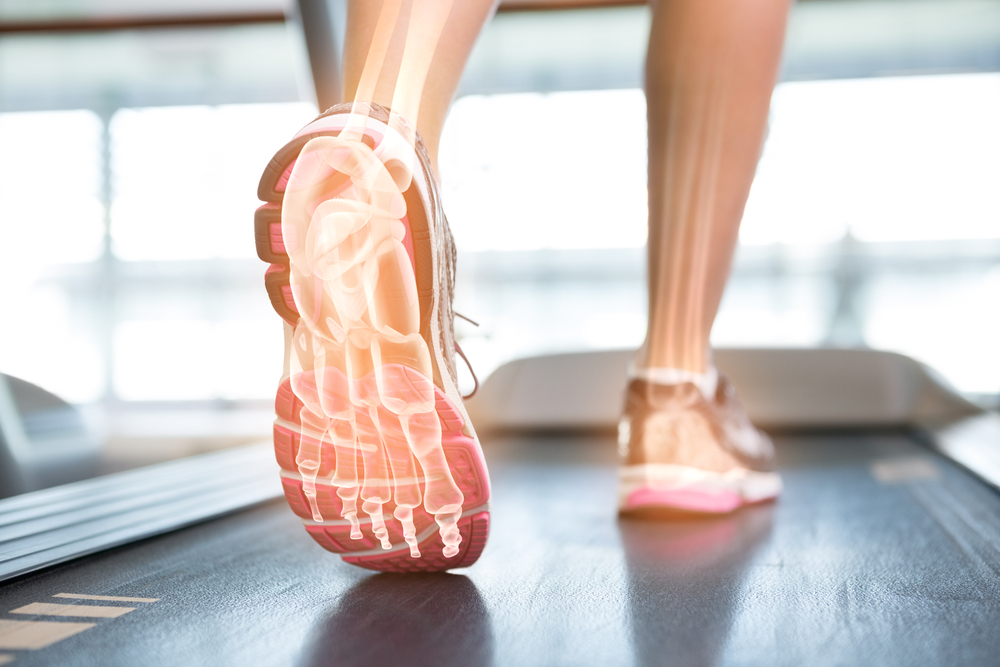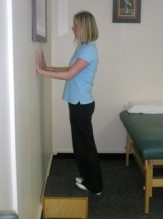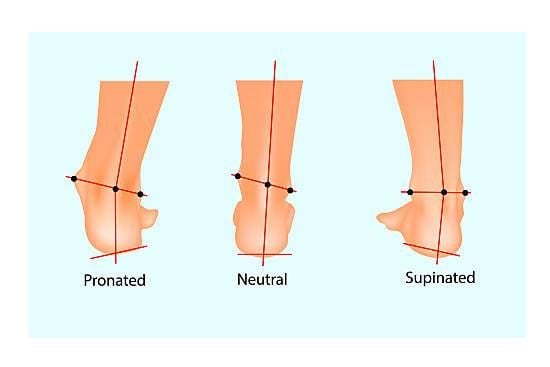The foot and ankle is made up of 28 bones, 55 articulations (where two bones interface with one another), and is connected with muscles, ligaments and strong fascia. Sounds complex right? It is! Fun fact: the foot and ankle have evolved over the years for more efficiency with ambulation on two feet.
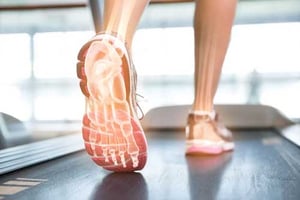
The foot is broken down into three sections:
- Forefoot
- Midfoot
- Hindfoot
There are a significant number of muscles that act on the foot and ankle. These are extrinsic muscles meaning they originate outside of the foot and ankle but still are movers of those joints.
Extrinsic muscles of the foot
These muscles are: Gastrocnemius, Plantaris, Soleus, Tibialis Anterior, Tibialis Posterior, Fibularis Longus, Fibularis Brevis, Fibularis Tertius, Flexor Hallucis Longus, Flexor Digitorum Longus, Extensor Hallucis Longus, Extensor Digitorum Longus
The intrinsic muscles of the foot are as follows:
Abductor Hallucis, Abductor Digiti Minimi, Flexor Digitorum Brevis, Quadratus Plantae, Flexor Hallucis Brevis, Flexor Digiti Minimi, Adductor Hallucis, Plantar and Dorsal Interossi.
Foot arches?
- There are three main arches of the foot:
- Medial longitudinal
- Lateral longitudinal
- Transverse longitudinal
- Plantar flexion
- Dorsi flexion
- Inversion
- Eversion
These motions are important during walking! If you're still reading, good for you! The main takeaway here is that the foot and ankle are very complex joints! With them being more complex, there is a lot of room for dysfunction to occur. The foot is the first area to accept weight during gait and how the weight is distributed properly or improperly then affects up the kinetic chain. So a seemingly "small" problem at the foot or ankle has big repercussions.
That being said, a hip problem might not just be a hip problem but also a foot problem. A foot problem might not be just a foot problem but also a hip problem. As we dive into evaluation and treatment of our patients, its not uncommon to see these compensatory issues up and down the kinetic chain.
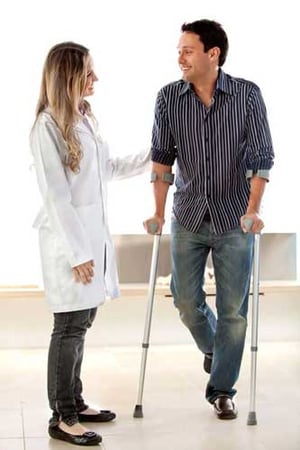
Do I have a foot problem?
Pain first of all. This tends to be our first indicator something is wrong. And rightfully so, its our body's natural alarm system to injury. The pain might be directly located where the injury is or in a compensatory area that has been affected by the injury. Next or concurrently with pain is decreased range of motion. You might not be able to move that area, or again, a joint adjacent to the injury. This can be due to swelling but may also be because of decreased extensibility in the muscles and connective tissue. Bruising and swelling is common with acute injuries such as an ankle sprain!
All of the above symptoms can then manifest themselves as decreased tolerance to walking, stairs, and/or your usual exercise routine.
Regardless of which symptom came first, if they aren't improving after a week it's a good idea to get a visit with your friendly neighborhood physical therapist for an evaluation.
Physical therapy Evaluation
Your physical therapist will start with getting a detailed history of your symptoms. How long has this been going on? What were you doing when the symptoms started? What makes your symptoms better or worse? This helps lead them to a an initial theory about your injury and the tissue involved. Sometimes the diagnosis is obvious such as a lateral ankle sprain. Next, they will assess your gait. How do you move? Are you compensating somewhere for the pain? A lot can be learned from watching your gait. Balance goes hand and hand with this. Understandably your balance on the affected lower extremity might be decreased but it's good to get a baseline assessment of it. One of the simplest ways to do this is a single leg stance (with your therapist spotting you and something nearby to hold onto).
Ankle Range of Motion (ROM)
Range of motion comes up next. We want to see how that joint moves as well as the ones around it. We want to see you move it but then we will also move it to get a sense for the joint restrictions (if there are any). This starts to set up some of your treatment intervention. Finally, strength testing and special tests. All those muscles we talked about up above? We want to see how they are functioning. There are also a variety of special tests that can stress various tissues and can give us a confirmation of what we thing could be going on.
Manual Therapy
We will wrap up your session with some manual therapy thats targeted to decease tenderness, increase tissue extensibility and joint mobility. Ideally, you'll be able to move a little better and with less amounts of pain. Manual therapy may look like massage, joint mobilizations, muscle energy techniques, dry needling and more. Not every patient will benefit or need the same manual strategies. Speak up if something is bothering you! Everyone has different sensitivities to touch, especially during injury. We can always adjust our technique.
There may be an exercise or two that reinforces proper mechanics and the beginnings of strengthening. Our goal isn't to give you 15 different exercises to complete every day. That is unrealistic and not effective. It only adds to patients not completing any exercises, even the best ones! If an exercise is too hard or causing pain, please let you therapist know. That kind of feedback is really important for developing your treatment plan. Just like you are getting to know us, we are getting to know you and your body.
Follow up Treatments
In subsequent treatment sessions we will get a brief history of the last few days since we last saw you. Combined with an analysis of tissue tension and tenderness, we will formulate a plan for that day. Some sessions will look very similar, gradually tweaking our interventions for optimal progress. However, all will include some form of manual therapy and exercise!
Because the foot and ankle complex, is well, so complex, there is a lot of dysfunction that can occur there. Some of the more common ones are as follows:
Stress FracturesBunions
Achilles tendonitis
Rolled Ankle
Morton's Neuroma
Plantar Fasciitis
Foot Pain
Overpronation
Stress Fractures
Stress fractures are common in the foot in those who are highly active. Repetitive forces, often from over use without adequate rest periods. Such as with running or jumping. Also commonly seen with high volume increases in activity and big jumps in milage for runners. Thus, resulting in these are micro fractures that if left untreated can cause a bigger displaced fracture.
Bunions
Bunions are easily diagnosable as a protrusion or "bump" on the side of the big toe. They are typically painful with movement and even to touch. You may lack range of motion and have difficulty walking. They are caused by deviation of the first metatarsal medially and the first phalanx to move laterally.
Achilles Tendonitis
Your achilles tendon is a thick, fibrous tendon that originates from the gastrocnemius muscle and is the connecting point into the calcaneous, which is a bone in the foot. This tendon can be shortened over time by a tight gastroc muscle, as well as become inflammed. The inflammation comes into play, similarly to stress fractures with overuse. There is then microtearing of the achilles tendon.
Rolled Ankle
Twisting your ankle is very common, regardless of how active you are. Most frequently individuals sustain a lateral ankle sprain. When this occurs the ligaments that are displaced are: Anterior talofibular ligament (ATFL) and/or the calcaneofibular ligament (CFL). The Posterior talofibular ligament (PTFL) is also part of the lateral complex but not as frequently injured. Swelling and/or bruising and obviously pain are most common symptoms.
Mortons Neuroma
A neuroma is a thickening of connective tissue around the nerve. What make's it a morton's neuroma (as opposed to anywhere else in the body) is the location. They are between the third and fourth toes, although can happen the second and third toes but not as commonly. It may feel like you have a marble in your foot! Walking and standing will feel painful, as well as palpation to that thickened tissue.
Plantar Fasciitis
We have connective tissue everywhere in our body, including the bottom of our feet. The thickened fascia thats on the underside of our feet is the plantar fascia. They can become tensioned, and very tender through poor foot biomechanics.
Foot Pain
Foot pain seems overly simple when dealing with the complexities of the foot and ankle. However, it is one of the first symptoms to show up when you're experiencing dysfunction at these joints. Pain lets our body know something is amiss, and to protect it from further injury. Some times our nervous system gets its wires crossed (pun intended) and it's protecting tissues that no longer need protecting.
Overpronation
Pronation has long been given a bad name, and its not entirely justified. Pronation is actually an important part of gait and weight baring. As with anything, too much of a good thing is not exactly a good thing any more. Same goes for pronation. Mal alignment of the foot creates a cascade effect up the kinetic chain, creating possible problems at the knee and hip.
The major take away here, is that the foot and ankle are very intricately constructed. It is the first area to accept weight when in standing and walking. If that positioning is off there are lot of issues that can arise in various parts of the body. Fear not though! Physical therapy is an excellent place to start if you are experiencing foot and ankle pain thats limiting your daily life! It's easy to forget about the foot and ankle but it deserves as much attention as any other area of the body.
Physical therapy for the foot and ankle joint in Columbia and Baltimore, Maryland
If you are experiencing foot and ankle pain, and its keeping you from living your life the fullest, contact us today!

